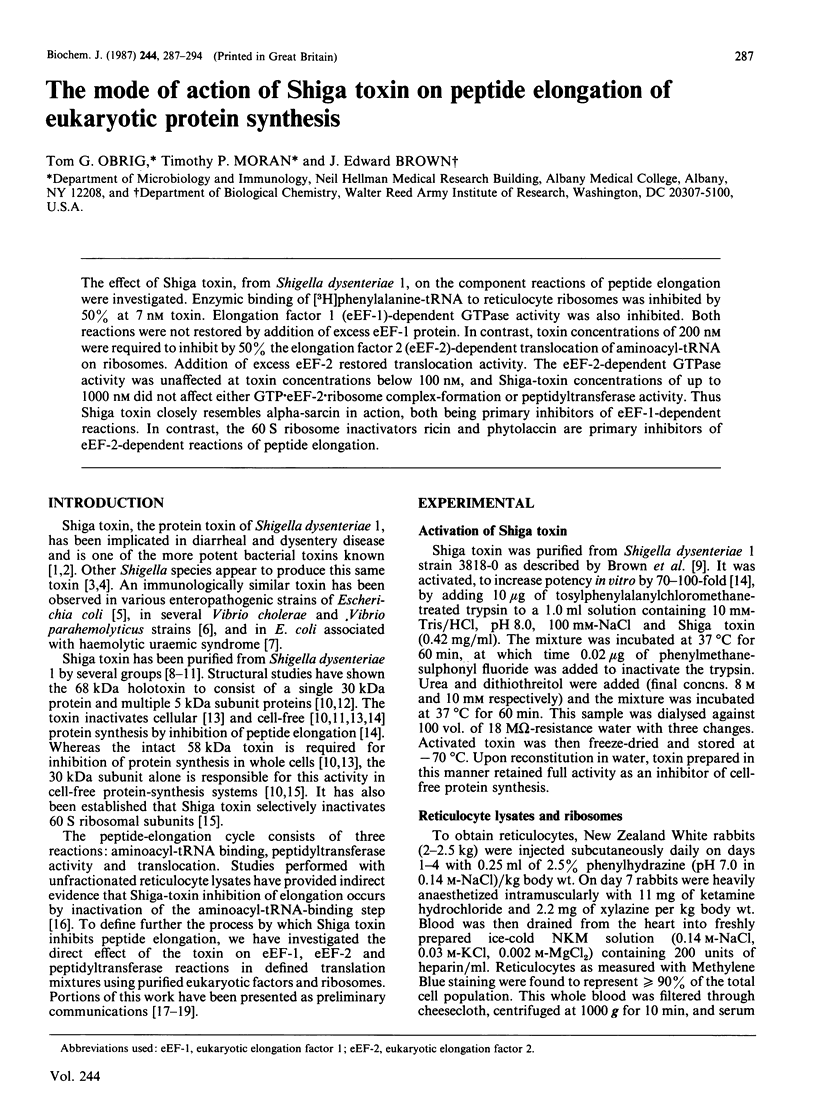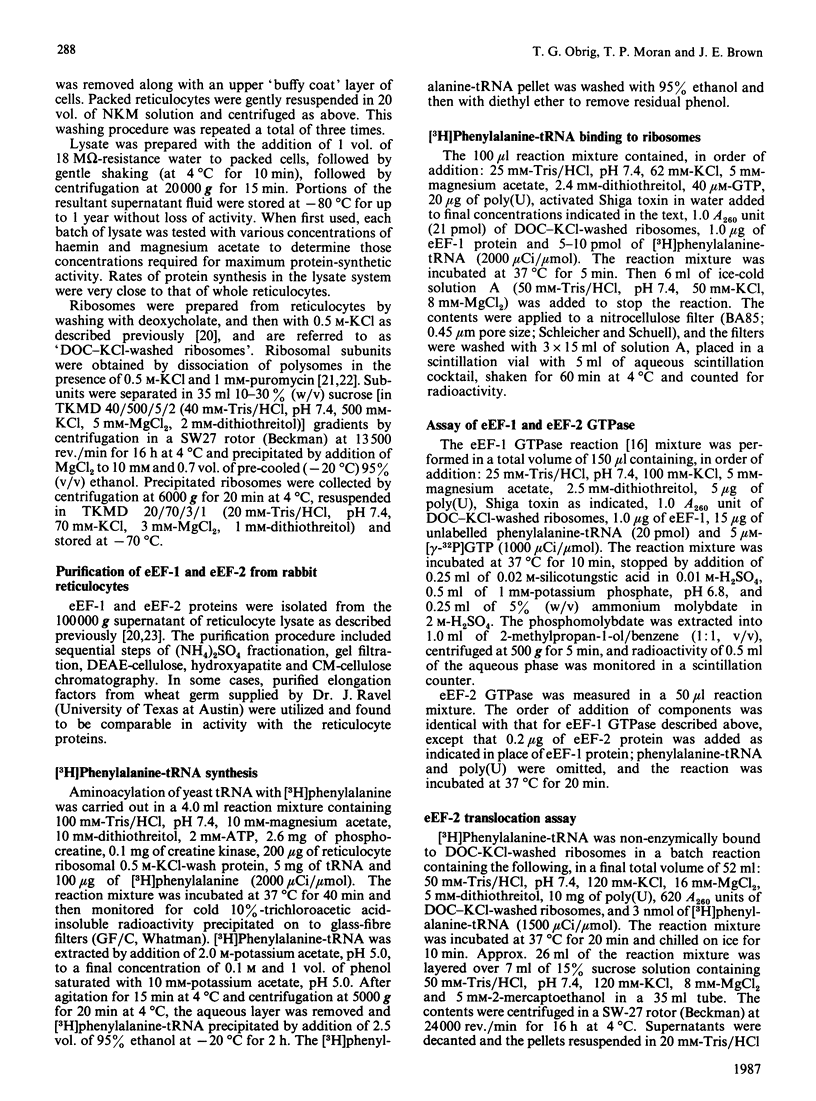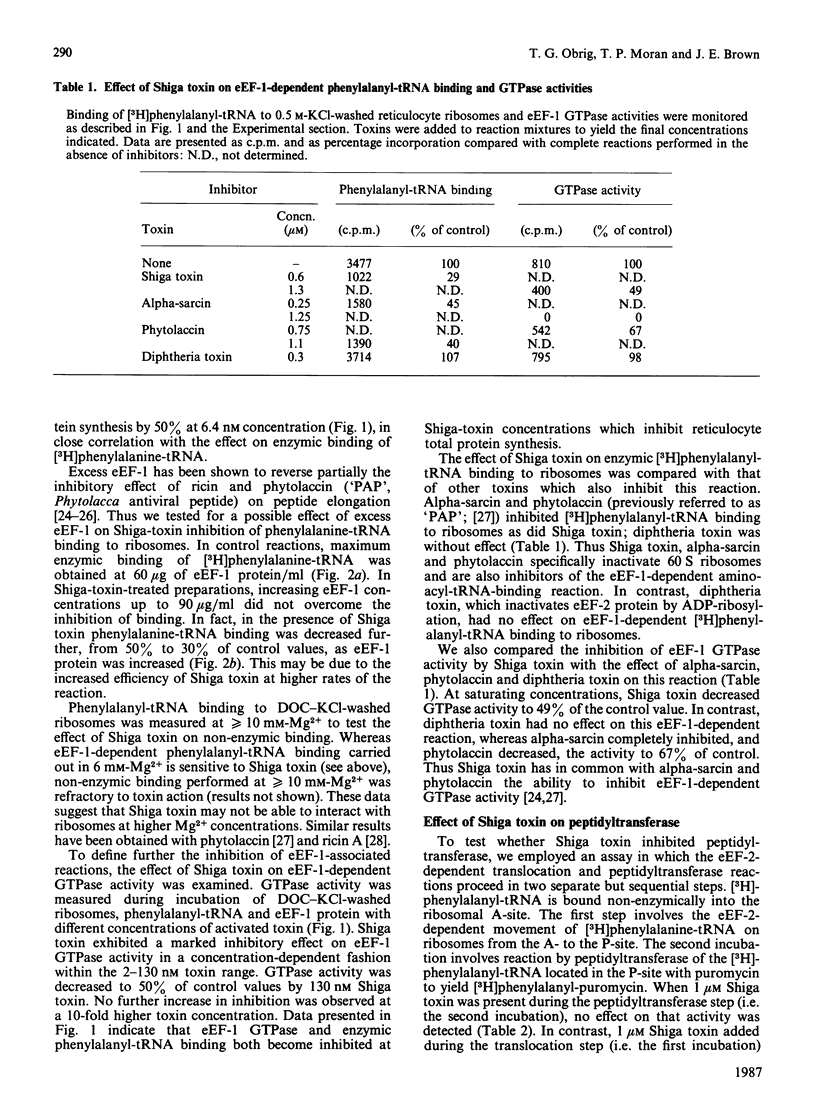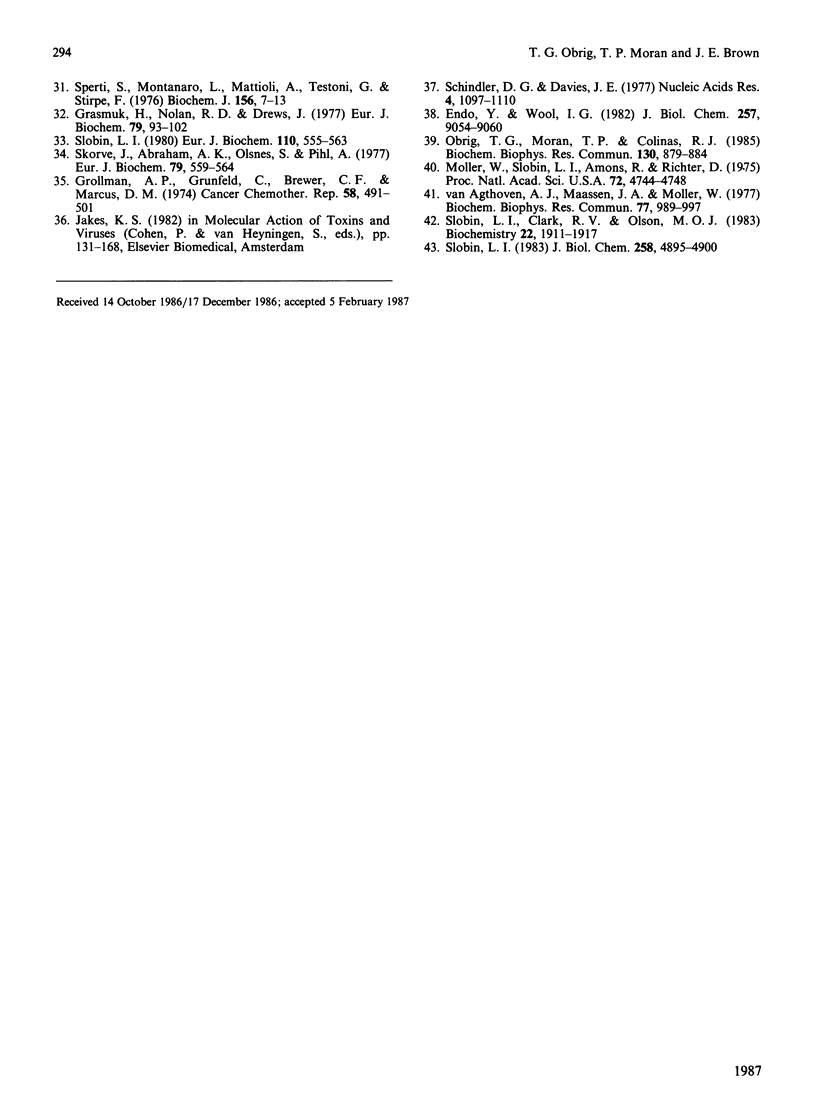Abstract
The effect of Shiga toxin, from Shigella dysenteriae 1, on the component reactions of peptide elongation were investigated. Enzymic binding of [3H]phenylalanine-tRNA to reticulocyte ribosomes was inhibited by 50% at 7 nM toxin. Elongation factor 1 (eEF-1)-dependent GTPase activity was also inhibited. Both reactions were not restored by addition of excess eEF-1 protein. In contrast, toxin concentrations of 200 nM were required to inhibit by 50% the elongation factor 2 (eEF-2)-dependent translocation of aminoacyl-tRNA on ribosomes. Addition of excess eEF-2 restored translocation activity. The eEF-2-dependent GTPase activity was unaffected at toxin concentrations below 100 nM, and Shiga-toxin concentrations of up to 1,000 nM did not affect either GTP.eEF-2.ribosome complex-formation or peptidyltransferase activity. Thus Shiga toxin closely resembles alpha-sarcin in action, both being primary inhibitors of eEF-1-dependent reactions. In contrast, the 60 S ribosome inactivators ricin and phytolaccin are primary inhibitors of eEF-2-dependent reactions of peptide elongation.
Full text
PDF







Selected References
These references are in PubMed. This may not be the complete list of references from this article.
- Blobel G. A protein of molecular weight 78,000 bound to the polyadenylate region of eukaryotic messenger RNAs. Proc Natl Acad Sci U S A. 1973 Mar;70(3):924–928. doi: 10.1073/pnas.70.3.924. [DOI] [PMC free article] [PubMed] [Google Scholar]
- Brown J. E., Griffin D. E., Rothman S. W., Doctor B. P. Purification and biological characterization of shiga toxin from Shigella dysenteriae 1. Infect Immun. 1982 Jun;36(3):996–1005. doi: 10.1128/iai.36.3.996-1005.1982. [DOI] [PMC free article] [PubMed] [Google Scholar]
- Brown J. E., Obrig T. G., Ussery M. A., Moran T. P. Shiga toxin from Shigella dysenteriae 1 inhibits protein synthesis in reticulocyte lysates by inactivation of aminoacyl-tRNA binding. Microb Pathog. 1986 Aug;1(4):325–334. doi: 10.1016/0882-4010(86)90065-3. [DOI] [PubMed] [Google Scholar]
- Brown J. E., Rothman S. W., Doctor B. P. Inhibition of protein synthesis in intact HeLa cells by Shigella dysenteriae 1 toxin. Infect Immun. 1980 Jul;29(1):98–107. doi: 10.1128/iai.29.1.98-107.1980. [DOI] [PMC free article] [PubMed] [Google Scholar]
- Brown J. E., Ussery M. A., Leppla S. H., Rothman S. W. Inhibition of protein synthesis by Shiga toxin: activation of the toxin and inhibition of peptide elongation. FEBS Lett. 1980 Aug 11;117(1):84–88. doi: 10.1016/0014-5793(80)80918-5. [DOI] [PubMed] [Google Scholar]
- Cantey J. R. Shiga toxin--an expanding role in the pathogenesis of infectious diseases. J Infect Dis. 1985 May;151(5):766–771. doi: 10.1093/infdis/151.5.766. [DOI] [PubMed] [Google Scholar]
- Donohue-Rolfe A., Keusch G. T., Edson C., Thorley-Lawson D., Jacewicz M. Pathogenesis of Shigella diarrhea. IX. Simplified high yield purification of Shigella toxin and characterization of subunit composition and function by the use of subunit-specific monoclonal and polyclonal antibodies. J Exp Med. 1984 Dec 1;160(6):1767–1781. doi: 10.1084/jem.160.6.1767. [DOI] [PMC free article] [PubMed] [Google Scholar]
- Endo Y., Wool I. G. The site of action of alpha-sarcin on eukaryotic ribosomes. The sequence at the alpha-sarcin cleavage site in 28 S ribosomal ribonucleic acid. J Biol Chem. 1982 Aug 10;257(15):9054–9060. [PubMed] [Google Scholar]
- Fernandez-Puentes C., Vazquez D. Effects of some proteins that inactivate the eukaryotic ribosome. FEBS Lett. 1977;78(1):143–146. doi: 10.1016/0014-5793(77)80292-5. [DOI] [PubMed] [Google Scholar]
- Fernández-Puentes C., Carrasco L., Vázquez D. Site of action of ricin on the ribosome. Biochemistry. 1976 Oct 5;15(20):4364–4369. doi: 10.1021/bi00665a003. [DOI] [PubMed] [Google Scholar]
- Grasmuk H., Nolan R. D., Drews J. Further evidence that elongation factor 1 remains bound to ribosomes during peptide chain elongation. Eur J Biochem. 1977 Sep 15;79(1):93–102. doi: 10.1111/j.1432-1033.1977.tb11787.x. [DOI] [PubMed] [Google Scholar]
- Grollman A. P., Grunfeld C., Brewer C. F., Marcus D. M. Molecular pharmacology of plant lectins: studies on ricin and concanavalin A (NSC-143504). Cancer Chemother Rep. 1974 Jul-Aug;58(4):491–501. [PubMed] [Google Scholar]
- Irvin J. D., Kelly T., Robertus J. D. Purification and properties of a second antiviral protein from Phytolacca americana which inactivates eukaryotic ribosomes. Arch Biochem Biophys. 1980 Apr 1;200(2):418–425. doi: 10.1016/0003-9861(80)90372-0. [DOI] [PubMed] [Google Scholar]
- Karmali M. A., Petric M., Lim C., Fleming P. C., Arbus G. S., Lior H. The association between idiopathic hemolytic uremic syndrome and infection by verotoxin-producing Escherichia coli. J Infect Dis. 1985 May;151(5):775–782. doi: 10.1093/infdis/151.5.775. [DOI] [PubMed] [Google Scholar]
- Keusch G. T., Jacewicz M. The pathogenesis of Shigella diarrhea. VI. Toxin and antitoxin in Shigella flexneri and Shigella sonnei infections in humans. J Infect Dis. 1977 Apr;135(4):552–556. doi: 10.1093/infdis/135.4.552. [DOI] [PubMed] [Google Scholar]
- O'Brien A. D., Chen M. E., Holmes R. K., Kaper J., Levine M. M. Environmental and human isolates of Vibrio cholerae and Vibrio parahaemolyticus produce a Shigella dysenteriae 1 (Shiga)-like cytotoxin. Lancet. 1984 Jan 14;1(8368):77–78. doi: 10.1016/s0140-6736(84)90006-0. [DOI] [PubMed] [Google Scholar]
- O'Brien A. D., LaVeck G. D., Griffin D. E., Thompson M. R. Characterization of Shigella dysenteriae 1 (Shiga) toxin purified by anti-Shiga toxin affinity chromatography. Infect Immun. 1980 Oct;30(1):170–179. doi: 10.1128/iai.30.1.170-179.1980. [DOI] [PMC free article] [PubMed] [Google Scholar]
- O'Brien A. D., LaVeck G. D. Purification and characterization of a Shigella dysenteriae 1-like toxin produced by Escherichia coli. Infect Immun. 1983 May;40(2):675–683. doi: 10.1128/iai.40.2.675-683.1983. [DOI] [PMC free article] [PubMed] [Google Scholar]
- O'Brien A. D., LaVeck G. D., Thompson M. R., Formal S. B. Production of Shigella dysenteriae type 1-like cytotoxin by Escherichia coli. J Infect Dis. 1982 Dec;146(6):763–769. doi: 10.1093/infdis/146.6.763. [DOI] [PubMed] [Google Scholar]
- O'Brien A. D., Thompson M. R., Gemski P., Doctor B. P., Formal S. B. Biological properties of Shigella flexneri 2A toxin and its serological relationship to Shigella dysenteriae 1 toxin. Infect Immun. 1977 Mar;15(3):796–798. doi: 10.1128/iai.15.3.796-798.1977. [DOI] [PMC free article] [PubMed] [Google Scholar]
- Obrig T. G., Culp W. J., McKeehan W. L., Hardesty B. The mechanism by which cycloheximide and related glutarimide antibiotics inhibit peptide synthesis on reticulocyte ribosomes. J Biol Chem. 1971 Jan 10;246(1):174–181. [PubMed] [Google Scholar]
- Obrig T. G., Irvin J. D., Hardesty B. The effect of an antiviral peptide on the ribosomal reactions of the peptide elongation enzymes, EF-I and EF-II. Arch Biochem Biophys. 1973 Apr;155(2):278–289. doi: 10.1016/0003-9861(73)90116-1. [DOI] [PubMed] [Google Scholar]
- Obrig T. G., Moran T. P., Colinas R. J. Ribonuclease activity associated with the 60S ribosome-inactivating proteins ricin A, phytolaccin and Shiga toxin. Biochem Biophys Res Commun. 1985 Jul 31;130(2):879–884. doi: 10.1016/0006-291x(85)90498-x. [DOI] [PubMed] [Google Scholar]
- Olsnes S., Reisbig R., Eiklid K. Subunit structure of Shigella cytotoxin. J Biol Chem. 1981 Aug 25;256(16):8732–8738. [PubMed] [Google Scholar]
- Reisbig R., Olsnes S., Eiklid K. The cytotoxic activity of Shigella toxin. Evidence for catalytic inactivation of the 60 S ribosomal subunit. J Biol Chem. 1981 Aug 25;256(16):8739–8744. [PubMed] [Google Scholar]
- Schindler D. G., Davies J. E. Specific cleavage of ribosomal RNA caused by alpha sarcin. Nucleic Acids Res. 1977 Apr;4(4):1097–1110. doi: 10.1093/nar/4.4.1097. [DOI] [PMC free article] [PubMed] [Google Scholar]
- Skorve J., Abraham A. K., Olsnes S., Pihl A. Effect of abrin on peptide chain initiation. Eur J Biochem. 1977 Oct 3;79(2):559–564. doi: 10.1111/j.1432-1033.1977.tb11840.x. [DOI] [PubMed] [Google Scholar]
- Slobin L. I. Binding of eucaryotic elongation factor Tu to nucleic acids. J Biol Chem. 1983 Apr 25;258(8):4895–4900. [PubMed] [Google Scholar]
- Slobin L. I., Clark R. V., Olson M. O. Limited cleavage of eucaryotic elongation factor Tu by trypsin: alignment of the tryptic fragments and effect of nucleic acids on the enzymatic reaction. Biochemistry. 1983 Apr 12;22(8):1911–1917. doi: 10.1021/bi00277a027. [DOI] [PubMed] [Google Scholar]
- Slobin L. I. The role of eucaryotic factor Tu in protein synthesis. The measurement of the elongation factor Tu content of rabbit reticulocytes and other mammalian cells by a sensitive radioimmunoassay. Eur J Biochem. 1980 Sep;110(2):555–563. doi: 10.1111/j.1432-1033.1980.tb04898.x. [DOI] [PubMed] [Google Scholar]
- Sperti S., Montanaro L., Mattioli A., Testoni G., Stirpe F. Inhibition of protein synthesis in vitro by crotins and ricin. Effect on the steps of peptide chain elongation. Biochem J. 1976 Apr 15;156(1):7–13. doi: 10.1042/bj1560007. [DOI] [PMC free article] [PubMed] [Google Scholar]
- Thompson M. R., Steinberg M. S., Gemski P., Formal S. B., Doctor B. P. Inhibition of in vitro protein synthesis by Shigella dysenteriae 1 toxin. Biochem Biophys Res Commun. 1976 Aug 9;71(3):783–788. doi: 10.1016/0006-291x(76)90899-8. [DOI] [PubMed] [Google Scholar]
- van Agthoven A. J., Maassen J. A., Möller W. Structure and phosphorylation of an acidic protein from 60S ribosomes and its involvement in elongation factor-2 dependent GTP hydrolysis. Biochem Biophys Res Commun. 1977 Aug 8;77(3):989–998. doi: 10.1016/s0006-291x(77)80075-2. [DOI] [PubMed] [Google Scholar]


